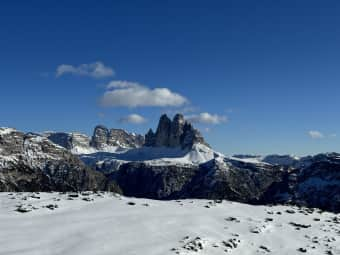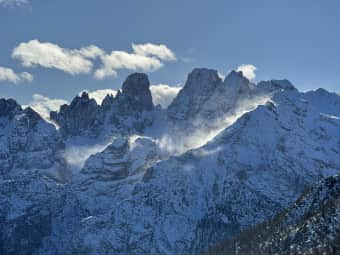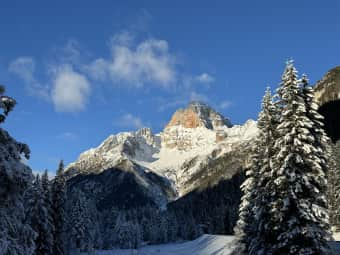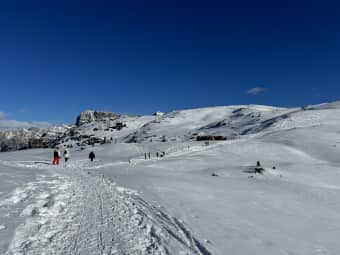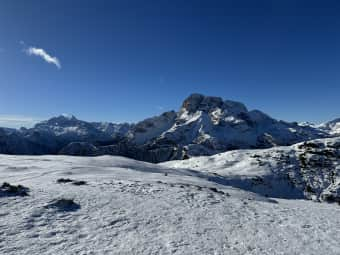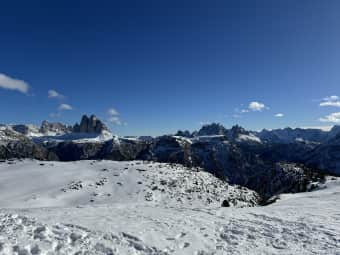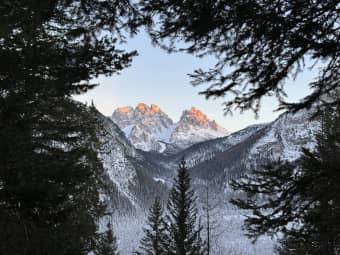2024 has begun, a new year is making its way and what better way to inaugurate it than with a splendid excursion in the snow? The weather promises a perfect day and so together with our companion from previous adventures, Alessandro, we set our sights on the new Mount Specie. This peak has more than one name given its belonging to Austria until the end of the First World War. It is also mentioned by the historian Ottone Brentari in his 1886 book Guida Storico-Alpina del Cadore in the passage from Cimabanche towards Dobbiaco: Then leave yourself alone. the Knollkopf (m. 2200) the V. of Platser and the Strudelköpfe, and on the right. the Rauhkofel, per kilo. 18 from Cortina, 11 from Botestagno, you reach Schluderbach (d. 1442). The locality was called, until a few years ago, with its Italian name, Carbonin. I imagine it's difficult to find the right nickname among all these German-language names. The Specie mountain is also called Strudelköpfe!
We park the car right in Carbonin, in a roadside clearing a few hundred meters from the Ploner hotel/village. The sky is a clear blue, it is 9:30 in the morning and the temperature is -8 degrees Celsius. All around us the trees are covered in a thin layer of snow. Even though the route should be completely beaten, we bring snowshoes with us to avoid unpleasant surprises. Backpack on our shoulders and, before crossing the road, we admire the Croda Rossa d'Ampezzo kissed by the first rays of the morning sun.
We reach the opposite side of the main road from which the CAI 37 path starts towards Prato Piazza and the Vallandro refuge. The ascent route is a wide mule track, well-groomed by the snowcat and with a gentle and never steep slope. The first meters of altitude are spent in the undergrowth, in the shade of snow-covered fir trees and accompanied by the crunching of snow under your boots. At an altitude of approximately 1600 metres, at the third bend, the vegetation thins out and the sun begins to warm us, giving us a sweet warmth. A few steps from here, on the right edge of the path, you can see a stone slab where several names of Italian soldiers of a brigade from the First World War are indicated.
We continue to climb on the mule track, moving further and further into the Val di Specie (Seelandtal), on our right the sometimes rocky coast of the Alpe di Specie which with its walls hides the view of today's destination. At an altitude of approximately 1800 metres, at a hairpin bend that turns to the right, you can see the "milezinche path" that borders the mule track. I traveled this splendid wild route on the adventure of Cadin del Ghiacchiaio di Croda Red (click for full details on this particular trail).
We emerge completely from the vegetation at an altitude of approximately 1900 meters from which we can finally see the Vallandro refuge in the distance. On our left the Knollkopf ridge behind which there is the solitary Val dei Chenope (or Val dei Canope). We climb onto the snowpack that is increasingly rounded and devoid of flora to interrupt its whiteness. At the first bend we find ourselves in front of a spectacular panorama of the Cadini di Misurina and, even closer to us, the Cristallo Group in which Piz Popena and the top of Mount Cristallo can be distinguished. The adventures on the cengia Raule are clearly visible in the presence of the Cristallino di Misurina, the forcella Michele and the Glacier del Cristallo!
Last steps and we rejoin the road that comes from Prato Piazza, clearly visible in front of us. Behind, the snow-capped peaks of the Val di Braies. At an obvious crossroads with an adjoining wooden sign, we continue on the right and soon arrive at today's first stop: the Vallandro refuge! An imposing wooden structure, with a large open space in front, the refuge appears welcoming and well organised. For the lazy ones, it can be reached with very little effort by parking the car in Prato Piazza from Val di Braies, avoiding the difference in altitude of around 600 metres. With these temperatures and the route heavy with snow, it took us just under 2 hours to reach the refuge, breaks included.
Date
04-01-2024
Distance
20.12 KM
Hike type
Snowshoe Trekking
Ascent
869 mt
- Mountain
Monte Specie
- Address
Carbonin, Trentino Alto Adige, Italy
- Altitude
2309.00 m
- Refuges
Rifugio Vallandro
- Information
We leave Vallandro after a short break and take CAI path number 34 in the direction of Strudelkopf (Monte Specie). The path is right near the refuge and proceeds initially in a northerly direction, then deviates towards the south-east. The progression is quick thanks to the gentle slope. The never heavy snow allows us to advance comfortably and allows us to fully enjoy this white expanse dotted here and there with solitary fir trees. We are in fact on the Alpe di Specie, a place of Austrian outpost during the Great War. From the top, and from the more modest Col di Specie, cannons and howitzers were organized in the direction of Monte Piana. As proof of these statements of mine, in the book "Secret itineraries of the Great War in the Dolomites - Volume 4", Paolo Pozzato indicates this place among those crucial for the conquest of Monte Piano in the summer of 1915 and is The artillery present in the Austrian demonstration attack of 22 October 1917 is also reported: Participating in the bombing were: [...] - Strudelalpe (Alpe di Specie) ten.col. Frank: 2 cannons;
We reach the fork called Strudelsattel where there is also a small ruined barracks. Not far away, in the direction of Val Chiara, a stone obelisk recalls the Bavarian Alpine battalion who built it in 1915. The top of the mountain is in plain sight from this position and you can already enjoy a fantastic view. At this point the snow is more abundant at times, certainly also brought by the currents blowing from the fork. However, we are not slowed down also thanks to the snowshoes and, legs on our shoulders, we devour the last quarter of an hour to reach the summit: Monte Specie!
We are greeted by a cold, cutting wind that blows with inhuman force in all directions! The perceived temperature is several degrees below zero, we have to arm ourselves to avoid being stung by the crystals raised by this glacial breath. However, we cannot close our eyes so as not to miss any detail of the wonder that can be enjoyed in front of the large wooden cross that identifies the summit. In front of us the mighty Mount Rudo (Rautkofel) with the neighboring Croda dei Rondoi. This mountain was also the symbol of an Austrian station which allowed you to have an incredible view of Lavaredo and the Three Peaks in front. Moving our gaze towards the South-East we see them standing out and rising almost as if they are stretching three slender fingers towards the sky. A different perspective than usual gives us a slightly crushed but always unmistakable! A little further to the right are the modest Monte Piano and Monte Piana, the scene of bloody battles in the Great War. The battlefield surrounded by much more imposing peaks, like the one where we are now, used to observe and direct bombardments aimed at wiping out one or the other group from this table... a target practice. We continue in a southerly direction passing first through the Cadini di Misurina, the Marmarole and the Sorapiss to return to the prospectively closer peaks with the Cristallo Group. We continue the visual circle moving to the Tofane, thus ideally touching Cortina d'Ampezzo and its Croda Rossa which looms over us. The Vallandro Peak invites us to its peak from how close it is. Heading north we can admire anonymous whitewashed Austrian peaks and then end the 360 degrees on the distinguishable Croda dei Baranci.
It is easy to understand why the Austrians used Alpe di Specie as an observation area. From here you have a perfect view of practically the entire Dolomite front. You can see with extreme precision where it starts from Mount Rudo to its end in the Tofane area. We breathe in what remains of this indelible historical memory and retrace our steps to return to the refuge.
We retrace the ascent route back with the wind accompanying us up to the saddle. Now the sun warms us again on this day without clouds and with a blinding blue sky. At Vallandro we deserve a nice refreshing break based on typical products such as a tasty barley soup, the inevitable seasoned cappucci salad and a slice of buckwheat cake as a conclusion. We have rested far too much and as we go out we notice the last rays of the sun running to hide behind the sinuous lines of the Knollkopf.
We retrace the mule track and get lost in the woods which are now darker but still clearly visible with their white traces. Before arriving in Carbonin, among the branches of the trees we are caught by a splendid enrosadira that inflames the peaks of the Cadini di Misurina (see photo!). We return to the car park where the completely crystallized car awaits us at the beautiful temperature of -5 degrees Celsius.
Thus ends this adventure at Alpe di Specie. An excursion, which from Carbonin is for trained hikers as it has around 900 meters of altitude difference and 20km in length. If you choose, however, to park at Prato Piazza, the excursion becomes accessible to everyone with a small difference in altitude of approximately 350 meters to reach the top of Mount Specie in relative ease. An adventure that brings together different types of emotions: from the nature in which we are immersed, the beauty of the panorama with practically all the majestic Dolomite peaks in front of us, up to history and the First World War in which this mountain was the undisputed protagonist!
DifficultyExpert hikers - are generally signposted itineraries but with some difficulties: the terrain can consist of slippery slopes of grass, mixed rocks and grass, stony ground, slight snowy slopes or even single easy-to-climb rocky passages (use of hands in some places) . Although they are routes that do not require particular equipment, equipped sections can be presented even if they are not demanding. They require a good knowledge of the alpine environment, a safe step and the absence of vertigo. Physical preparation must be adequate for a fairly continuous day of walking. |
